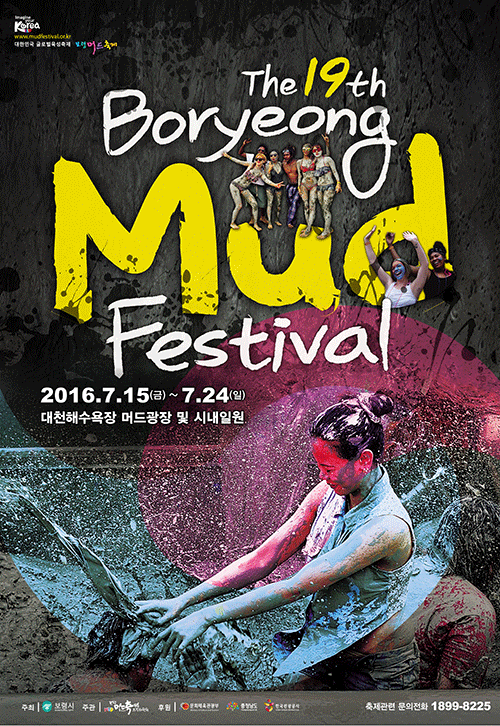Slated for for July 15-24
Boasting blessed landscape with beautiful sea, islands and mountains, the coastal city of Boryeong attracts more than 16 million tourists a year. The City also has wide beaches with clean sands and mud flats that have long been loved by tourists. As one of the five largest mud flats in the world, the mud flat on the West Coast of Korea, especially the one around Daecheon Beach in Boryeong City, is identified to contain beneficial 9 natural minerals, including aluminum, germanium, silicon, magnesium, potassium and calcium, as well as far-infrared radiation. And Muchangpo Beach, which was opened to summer vacationers in 1928 as the first beach on the West Coast, is well known as a miracle sea that allows tourists to experience the ‘Red Sea crossing.’

The sea mud powder and mud water produced in the City are comparable to those made of mud in Dead Sea of Israel, glacier mud on the coast in British Colombia, Canada, mud in Lake Baikal of Russia, clay mud in California, the United States, and volcano mud in New Zealand. These products are demonstrated to be exceptionally effective for skin care by preventing aging of skin and removing waste products from skin. With abundant clean and quality sea mud, the City has been hosting the Boryeong Mud Festival annually since 1998. The festival organizing committee will host the Boryeong Mud Festival for 10 days from July 15th(Friday)~ July 24th(Sunday) this year at the mud plaza on Daecheon Beach under the theme of ‘Exciting Mud Experience Together with World Citizens’.
Built on previous experiences, the mud festival in this year is conspicuously expanded with more colorful 60 programs, including 27 experiencing programs such as large mud bath, mud super slide and mud flat games, 7 exhibitions such as mud festival photography contest and exhibition of mud cosmetics, 15 affiliated events such as festival forum, road parade and Black Eagles’ air show, and 11 evening events such as concerts, traditional Korean music performance and fireworks festival. With a 19-year old history, the festival has grown as an international event, attracting over 300,000 foreign tourists a year. Particularly, the festival gained high popularity and was acclaimed by being selected as one of Korea’s representative festivals for the seventh consecutive year since 2008, and it was named as the ‘globally promotable festival of Korea’ by the government in 2015. Aiming to establish the mud festival as one of world’s top 10 festivals such as the ‘La Tomatina’, the tomato festival in Spain, and Rio Carnival in Brazil, the City government plans to host the Mud Expo in 2022.
Having found high quality mud in mud fields near Daecheon Beach, the City authority developed 16 different mud-based cosmetics including mud pack products in 1996, and it hosted the first Boryeong Mud Festival for 4 days in July 1998 with relatively less diverse programs as part of its efforts to promote and sell these products by enhancing awareness. Starting in the fourth festival in 2001, the festival period was extended to 7 days and expanded its programs, successfully increasing visitors from 312,000 persons in 1996 to 756,000 persons including 4,500 foreign tourists in 2001. As the festival attracted the largest number of foreign tourists among festivals in Korea, it was selected as the best festival in Korea by the Ministry of Culture, Sports and Tourism for the second consecutive year in 2006 and 2007. And it was also selected as one of Korea’s representative festivals for the seventh consecutive year since 2008. Moreover, the festival was honored with grand awards of the Korea Content Awards in global festival and festival direction segments in this year. Also, it received prizes in 9 segments (5 gold prizes, 2 silver prizes, and 2 bronze prizes) from the International Festivals and Events Association (IFEA) in 2014, meaning it was recognized as a world-level festival.
Marking its 14th anniversary in 2011, the festival organizing committee established a foundation to secure financial sustainability, while ambitiously expanding programs. In that year alone, the festival attracted nearly 3.3 million visitors, including 280,000 foreign tourists. And, the mayor and deputy mayor of Valencia, Spain attended the Boryeong Mud Festival in 2013 and 2014 respectively to conclude an agreement for exchange of festivals between the two cities. Based on the agreement, the La Tomatina Festival in Spain operated a day of experiencing the Boryeong Mud Festival in 2014, while the latter included the day of the La Tomatina Festival in its program in the same year. Besides the mud festival, the City government and local organizations are hosting several other annual festivals, including the spring flower festival, fish festival, beach art festival and autumn colors festival.
With proven efficacies in skin care, beauty treatment and treating diseases, mud is widely used as substances for cosmetics, soaps and drugs. After years-long research and analysis, the City government began producing mud cosmetics and soaps in 1996. Its mud products passed tests of skin irritation and heavy metal based on regulations of the U.S. Food & Drug Administration in December 2004, and mud soaps obtained the S Mark (anti-virus) from the Korea Testing & Research Institute in the following year. They won the grand prize of excellent regional products in Korea in 2006.

